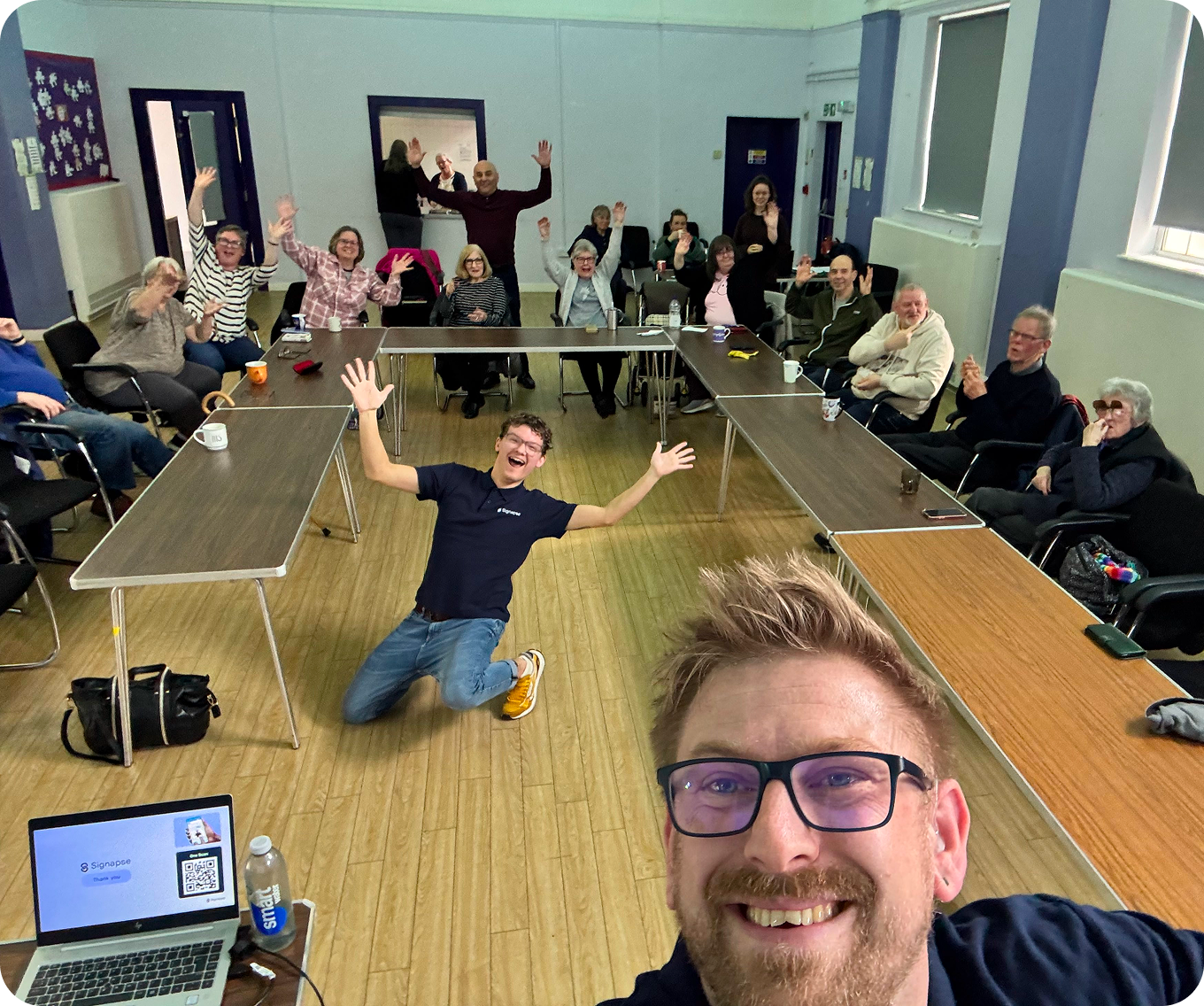From Classroom to Courtroom: The Many Roles of Sign Language Interpreters

For millions of Deaf and hard-of-hearing people across the world, sign language interpreters are more than professionals. They can be lifelines in education, justice, healthcare and everyday participation in society. From guiding a child through their first day of school to standing beside a defendant in a courtroom, interpreters work in diverse environments that demand not only linguistic skill but also cultural awareness, ethical judgement and emotional resilience.
This guide explores the types of interpretation services and their benefits, what it takes to qualify for each position, the unique challenges they face, and how technology is beginning to change the landscape of accessibility. Let’s take a look at how sign language interpreting has become an essential part of everyday life.
- Education: Supporting Learning and Inclusion
- Legal Settings: For Courtrooms to Police Interviews
- Medical and Healthcare Settings: Ensuring Accessible Care
- Workplace and Corporate Interpreting: Access to Professional Growth
- Media and Public Events: Accessibility on a Larger Stage
- Challenges in Sign Language Interpreting
- The Future: Technology as a Partner, Not a Replacement
- We’re Bridging Gaps Not Replacing Crucial Jobs
Education: Supporting Learning and Inclusion
Schools and universities are often where Deaf students first encounter interpreters. In the classroom, interpreters provide access to lectures, group discussions, labs and even extracurricular activities. The role goes beyond “word-for-word” translation. It’s about ensuring equal opportunity and participation.
BSL Sign Language Interpreters in Education
In the UK, the Equality Act 2010 requires educational institutions to provide “reasonable adjustments” for students. This includes providing sign language interpreters to help students not just learn, but thrive in educational settings.
ASL Sign Language Interpreters in Education
In the US, the Individuals with Disabilities Education Act (IDEA) and Americans with Disabilities Act (ADA) states schools must provide qualified interpreters when necessary. Without ASL interpreters, students may fall behind through the lack of clear communication. This shows having interpreters in schools is essential.
Legal Settings: For Courtrooms to Police Interviews
In legal contexts, accuracy can mean the difference between justice and a miscarriage of justice. Interpreters work in courtrooms, police stations, prisons and solicitor meetings. They must remain impartial while navigating highly technical and emotionally charged proceedings.
Sign Language in the UK Legal System
The Police and Criminal Evidence Act (PACE) and the Equality Act mandate communication access for Deaf individuals in legal proceedings in the UK. Sign language interpreters in legal settings usually require registration with the National Registers of Communication Professionals working with Deaf and Deafblind People (NRCPD). They may also specialise through police-approved training or experience in legal environments.
Sign Language in the US Legal System
There are slightly different requirements in the US. Under the ADA and Section 504 of the Rehabilitation Act, courts must provide interpreters. The Registry of Interpreters for the Deaf (RID) offers a Legal Specialist Certificate that allows interpreters to act within the legal system. Court interpreters also often have to demonstrate their experience in legal terminology and proceedings. The requirements may also differ from state to state.
Medical and Healthcare Settings: Ensuring Accessible Care
From GP visits to emergency surgery, interpreters in healthcare settings provide critical support. Their presence ensures Deaf patients can make informed decisions and understand medical advice when it is most important.
Sign Language Interpretation in UK Healthcare
In the UK, the NHS Accessible Information Standard (2016) requires NHS providers to meet communication needs, including provision of interpreters. For interpreters, a NRCPD registration is needed alongside familiarity with healthcare contexts, especially when it comes to mental health services.
Sign Language Interpretation in the US Healthcare System
In the US, hospitals must comply with ADA and Section 504, as well as the Affordable Care Act (2010). While general RID certification is often acceptable, healthcare-specific training is strongly recommended as knowledge of healthcare terminology is a must. ASL medical interpreting also highlights the importance of patient confidentiality (HIPPA compliance).
Workplace and Corporate Interpreting: Access to Professional Growth
In workplaces, sign language interpreters ensure Deaf employees can participate fully in staff meetings, training sessions and interviews. They also support businesses in complying with accessibility laws and creating inclusive work environments.
Professional Sign Language Interpretation in UK Workplaces
Under the Equality Act, employers must provide reasonable adjustments for all employees. There are funding options for interpreters through the Access to Work scheme that can help businesses provide these provisions. Sign language interpreters will often need NRCPD registration and potentially experience in business communication depending on the role of the Deaf individual they are interpreting for. The Regulatory Body for Sign Language Interpreters and Translators (RBSLI) is an alternative independent register that some sign language interpreters also choose to use.
Professional Sign Language Interpretation in US Workplaces
Similarly in the US, the ADA requires employers to provide “reasonable accommodations” including interpreters. A general interpreter certification is often enough for sign language interpreters operating in workplace environments but some interpreters may prefer to develop industry-specific vocabularies.
Media and Public Events: Accessibility on a Larger Stage
Interpreters are now a familiar sight at live events, press briefings, concerts and theatre performances. Their visibility during COVID-19 press conferences emphasised their importance on a national stage.
Sign Language Interpreters in UK Media
Public events often foster the feeling of community, but how can everyone feel involved if they cannot easily engage with the event? That’s where sign language interpreters come in. The Equality Act underpins this at public events. Campaigns in recent years have highlighted the inconsistent provision at UK government briefings. Interpreters often have specialist training in performance interpreting, particularly in theatre or music event settings.
Sign Language Interpreters in US Media
The ADA applies to public events in the US and broadcasters are increasingly expected to provide interpretation alongside captioning so that the Deaf community can more easily understand the information presented to them. Sign language interpreters on stage and screen usually require a high-level of fluency, fast processing and ability to adapt to live and unscripted events.
Challenges in Sign Language Interpreting
Sign language interpretation is not without its challenges. Though we can see the importance of sign language interpreters in every aspect of life, the role itself can still be difficult, especially in legal and medical environments. Here are some of the challenges sign language interpreters commonly face:
- Cognitive Load and Fatigue: Interpreting requires intense focus and is mentally exhausting. This is why sessions often need two interpreters working in tandem.
- Maintaining Neutrality: Especially in legal or medical contexts, interpreters must convey meaning without personal bias.
- Shortage of Professionals: Felt around the world, a shortage of qualified interpreters, leading to overwork and long waiting times.
- Variation in Sign Languages: British Sign Language (BSL) and American Sign Language (ASL) are distinct languages. Even within each, regional dialects and cultural nuances can complicate interpretation.
- Emotional Impact: Interpreters can witness distressing situations when working in the legal and medical industry. From domestic abuse cases to medical emergencies, translating these events can take a toll on mental health.
The Future: Technology as a Partner, Not a Replacement
While no technology can yet replace the nuance and human empathy of interpreters, advancements and innovations are helping to bridge gaps in access.
Video Remote Interpreting (VRI)
Widely used around the world, VRI connects Deaf clients to a video remote interpreter via video calls, with hearing parties in the same location. This is especially valuable in healthcare emergencies and rural areas where on-site interpreters are more difficult to find or unavailable. However, poor internet connections or limited device access can reduce its effectiveness.
AI and Sign Language Translation
At Signapse, we offer AI-powered sign language translation that can resolve issues in everyday communication. Best used in live events, broadcasts and for pre-made content, SignStudio and SignStream can easily translate your content into BSL and ASL so you can connect with Deaf members of your audience and include them in the conversation.
We’re Bridging Gaps Not Replacing Crucial Jobs
From classrooms filled with eager students to the solemn atmosphere of a courtroom, sign language interpreters play a vital role in ensuring equity and inclusion. Their work spans education, justice, healthcare, workplaces and public life, supported by the Equality Act in the UK and ADA in the US. However, the key challenge of interpreters is the shortage across the globe.
This is where technology, like ours at Signapse, can help fill in the gaps to lighten the load. By incorporating innovative solutions into your business or organisation, you can move one step closer to true accessibility that works alongside interpreters rather than excluding them.
Take a look our products, SignStudio and SignStream, today and book a demo to see how they can be implemented into your workflow.
FAQs
How to become an interpreter of ASL or BSL?
In the UK, aspiring BSL interpreters usually complete a Level 6 Diploma in Sign Language Interpreting and register with the NRCPD or RBSLI. To become an ASL interpreter in the US, you typically need a degree in interpreting or Deaf studies and certification from the Registry of Interpreters for the Deaf (RID).
Are BSL interpreters in demand?
Yes, there is a high demand for qualified BSL interpreters in England due to a national shortage. This often means long waiting times for services, but strong job opportunities for sign language interpreters.
Where can AI sign language technology be used?
AI sign language tools can support communication in more relaxed settings such as the workplace, live streams, broadcasts and customer service. From translating marketing materials to training documents and live sports events, our solutions at Signapse can flexibly adapt to your content. Book a demo today to see our technology in action!
Related Articles
Addressing the Challenges of Sign Language Interpretation
Unlocking the Web: Sign Language Translation for Websites
Bridging the Communication Gap for Deaf Individuals at Work
<blockquote class="instagram-media" data-instgrm-captioned data-instgrm-permalink="https://www.instagram.com/p/DQoj85EkQ52/?utm_source=ig_embed&utm_campaign=loading" data-instgrm-version="14" style=" background:#FFF; border:0; border-radius:3px; box-shadow:0 0 1px 0 rgba(0,0,0,0.5),0 1px 10px 0 rgba(0,0,0,0.15); margin: 1px; max-width:540px; min-width:326px; padding:0; width:99.375%; width:-webkit-calc(100% - 2px); width:calc(100% - 2px);"><div style="padding:16px;"> <a href="https://www.instagram.com/p/DQoj85EkQ52/?utm_source=ig_embed&utm_campaign=loading" style=" background:#FFFFFF; line-height:0; padding:0 0; text-align:center; text-decoration:none; width:100%;" target="_blank"> <div style=" display: flex; flex-direction: row; align-items: center;"> <div style="background-color: #F4F4F4; border-radius: 50%; flex-grow: 0; height: 40px; margin-right: 14px; width: 40px;"></div> <div style="display: flex; flex-direction: column; flex-grow: 1; justify-content: center;"> <div style=" background-color: #F4F4F4; border-radius: 4px; flex-grow: 0; height: 14px; margin-bottom: 6px; width: 100px;"></div> <div style=" background-color: #F4F4F4; border-radius: 4px; flex-grow: 0; height: 14px; width: 60px;"></div></div></div><div style="padding: 19% 0;"></div> <div style="display:block; height:50px; margin:0 auto 12px; width:50px;"><svg width="50px" height="50px" viewBox="0 0 60 60" version="1.1" xmlns="https://www.w3.org/2000/svg" xmlns:xlink="https://www.w3.org/1999/xlink"><g stroke="none" stroke-width="1" fill="none" fill-rule="evenodd"><g transform="translate(-511.000000, -20.000000)" fill="#000000"><g><path d="M556.869,30.41 C554.814,30.41 553.148,32.076 553.148,34.131 C553.148,36.186 554.814,37.852 556.869,37.852 C558.924,37.852 560.59,36.186 560.59,34.131 C560.59,32.076 558.924,30.41 556.869,30.41 M541,60.657 C535.114,60.657 530.342,55.887 530.342,50 C530.342,44.114 535.114,39.342 541,39.342 C546.887,39.342 551.658,44.114 551.658,50 C551.658,55.887 546.887,60.657 541,60.657 M541,33.886 C532.1,33.886 524.886,41.1 524.886,50 C524.886,58.899 532.1,66.113 541,66.113 C549.9,66.113 557.115,58.899 557.115,50 C557.115,41.1 549.9,33.886 541,33.886 M565.378,62.101 C565.244,65.022 564.756,66.606 564.346,67.663 C563.803,69.06 563.154,70.057 562.106,71.106 C561.058,72.155 560.06,72.803 558.662,73.347 C557.607,73.757 556.021,74.244 553.102,74.378 C549.944,74.521 548.997,74.552 541,74.552 C533.003,74.552 532.056,74.521 528.898,74.378 C525.979,74.244 524.393,73.757 523.338,73.347 C521.94,72.803 520.942,72.155 519.894,71.106 C518.846,70.057 518.197,69.06 517.654,67.663 C517.244,66.606 516.755,65.022 516.623,62.101 C516.479,58.943 516.448,57.996 516.448,50 C516.448,42.003 516.479,41.056 516.623,37.899 C516.755,34.978 517.244,33.391 517.654,32.338 C518.197,30.938 518.846,29.942 519.894,28.894 C520.942,27.846 521.94,27.196 523.338,26.654 C524.393,26.244 525.979,25.756 528.898,25.623 C532.057,25.479 533.004,25.448 541,25.448 C548.997,25.448 549.943,25.479 553.102,25.623 C556.021,25.756 557.607,26.244 558.662,26.654 C560.06,27.196 561.058,27.846 562.106,28.894 C563.154,29.942 563.803,30.938 564.346,32.338 C564.756,33.391 565.244,34.978 565.378,37.899 C565.522,41.056 565.552,42.003 565.552,50 C565.552,57.996 565.522,58.943 565.378,62.101 M570.82,37.631 C570.674,34.438 570.167,32.258 569.425,30.349 C568.659,28.377 567.633,26.702 565.965,25.035 C564.297,23.368 562.623,22.342 560.652,21.575 C558.743,20.834 556.562,20.326 553.369,20.18 C550.169,20.033 549.148,20 541,20 C532.853,20 531.831,20.033 528.631,20.18 C525.438,20.326 523.257,20.834 521.349,21.575 C519.376,22.342 517.703,23.368 516.035,25.035 C514.368,26.702 513.342,28.377 512.574,30.349 C511.834,32.258 511.326,34.438 511.181,37.631 C511.035,40.831 511,41.851 511,50 C511,58.147 511.035,59.17 511.181,62.369 C511.326,65.562 511.834,67.743 512.574,69.651 C513.342,71.625 514.368,73.296 516.035,74.965 C517.703,76.634 519.376,77.658 521.349,78.425 C523.257,79.167 525.438,79.673 528.631,79.82 C531.831,79.965 532.853,80.001 541,80.001 C549.148,80.001 550.169,79.965 553.369,79.82 C556.562,79.673 558.743,79.167 560.652,78.425 C562.623,77.658 564.297,76.634 565.965,74.965 C567.633,73.296 568.659,71.625 569.425,69.651 C570.167,67.743 570.674,65.562 570.82,62.369 C570.966,59.17 571,58.147 571,50 C571,41.851 570.966,40.831 570.82,37.631"></path></g></g></g></svg></div><div style="padding-top: 8px;"> <div style=" color:#3897f0; font-family:Arial,sans-serif; font-size:14px; font-style:normal; font-weight:550; line-height:18px;">View this post on Instagram</div></div><div style="padding: 12.5% 0;"></div> <div style="display: flex; flex-direction: row; margin-bottom: 14px; align-items: center;"><div> <div style="background-color: #F4F4F4; border-radius: 50%; height: 12.5px; width: 12.5px; transform: translateX(0px) translateY(7px);"></div> <div style="background-color: #F4F4F4; height: 12.5px; transform: rotate(-45deg) translateX(3px) translateY(1px); width: 12.5px; flex-grow: 0; margin-right: 14px; margin-left: 2px;"></div> <div style="background-color: #F4F4F4; border-radius: 50%; height: 12.5px; width: 12.5px; transform: translateX(9px) translateY(-18px);"></div></div><div style="margin-left: 8px;"> <div style=" background-color: #F4F4F4; border-radius: 50%; flex-grow: 0; height: 20px; width: 20px;"></div> <div style=" width: 0; height: 0; border-top: 2px solid transparent; border-left: 6px solid #f4f4f4; border-bottom: 2px solid transparent; transform: translateX(16px) translateY(-4px) rotate(30deg)"></div></div><div style="margin-left: auto;"> <div style=" width: 0px; border-top: 8px solid #F4F4F4; border-right: 8px solid transparent; transform: translateY(16px);"></div> <div style=" background-color: #F4F4F4; flex-grow: 0; height: 12px; width: 16px; transform: translateY(-4px);"></div> <div style=" width: 0; height: 0; border-top: 8px solid #F4F4F4; border-left: 8px solid transparent; transform: translateY(-4px) translateX(8px);"></div></div></div> <div style="display: flex; flex-direction: column; flex-grow: 1; justify-content: center; margin-bottom: 24px;"> <div style=" background-color: #F4F4F4; border-radius: 4px; flex-grow: 0; height: 14px; margin-bottom: 6px; width: 224px;"></div> <div style=" background-color: #F4F4F4; border-radius: 4px; flex-grow: 0; height: 14px; width: 144px;"></div></div></a><p style=" color:#c9c8cd; font-family:Arial,sans-serif; font-size:14px; line-height:17px; margin-bottom:0; margin-top:8px; overflow:hidden; padding:8px 0 7px; text-align:center; text-overflow:ellipsis; white-space:nowrap;"><a href="https://www.instagram.com/p/DQoj85EkQ52/?utm_source=ig_embed&utm_campaign=loading" style=" color:#c9c8cd; font-family:Arial,sans-serif; font-size:14px; font-style:normal; font-weight:normal; line-height:17px; text-decoration:none;" target="_blank">A post shared by Signapse | AI Powered Sign Language (@signapseltd)</a></p></div></blockquote>
<script async src="//www.instagram.com/embed.js"></script>


